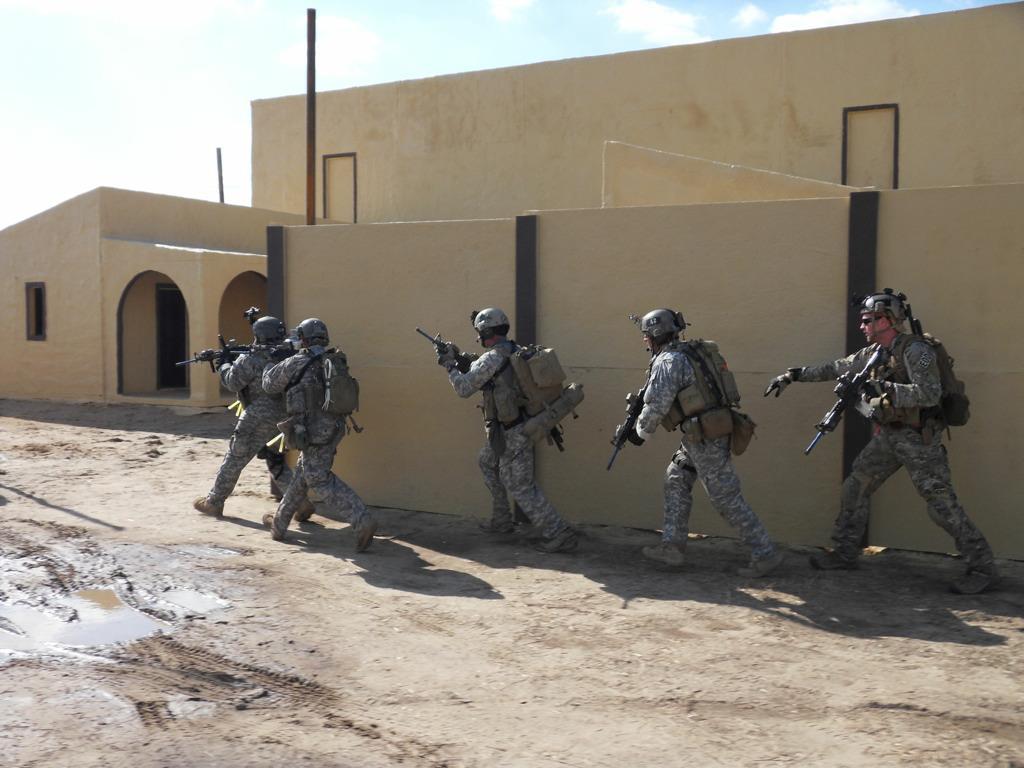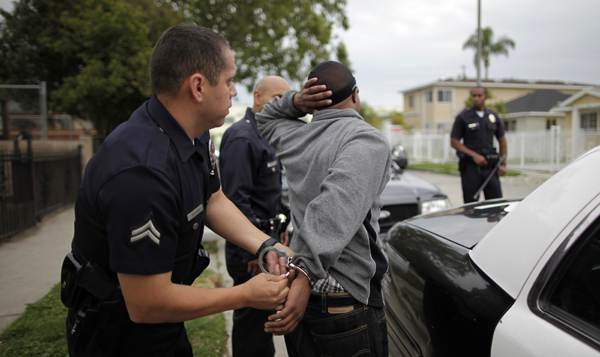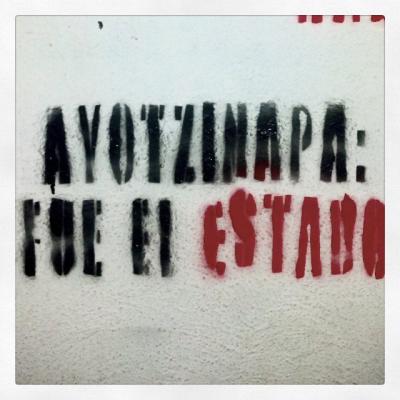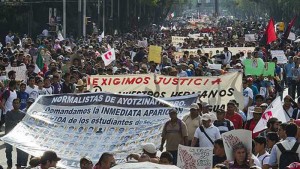The War on Drugs was a direct response to the African American uprisings of the 1960s. Its racist and repressive effects continue to be felt today.
By Paul Bermanzohn. Published August 13, 2015, by ROAR.
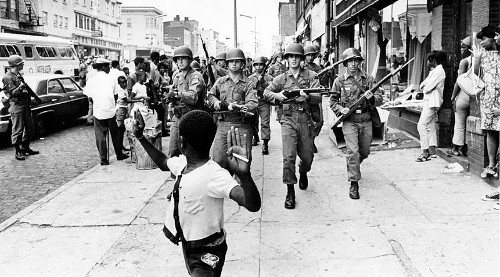
Photo: A scene of the 1967 Newark Rebellion, by Don Hogan Charles.
Recent US history, from the 1960s until today, shows the War on Drugs to be a crusade of repression against African American people, incarcerating millions to prevent a renewal of the struggle for freedom.
We need to look at the whole picture of this drug war, not just a fragment or a piece of it. Most writers on this subject either get lost in the details or cannot see past the lie that the US is a “democracy.” In either case they often fail to see the realities of this history, even though the facts are clear. Presenting well-known events in chronological order clarifies the inner connection among these events and brings out their larger significance.
Indeed, placing the history in sequence makes it plain: the Great Migration brought on a Great Rebellion. A vindictive Great Repression was orchestrated to crush the Great Rebellion and prevent its continuation. Masked as the so-called “War on Drugs,” which has swept millions into prisons and jails across the US, the Great Repression has, in effect, punished generations for the “sins” of their ancestors — those who dared to rebel.
This repression is still underway today. Its effects are clearly racial. But, camouflaged as a “War on Drugs,” it has allowed the country’s rulers to appear “colorblind” or race-neutral — as if they are merely enforcing the law.
The Great Migration
In the early 20th century, fleeing the decaying Jim Crow system of agricultural labor in the fields and farms of the South, millions of African Americans moved out, seeking jobs in the military-industrial centers of the North, the mid West and the West. From World War I to the 1960s, millions migrated from virtual chattel slavery in the South to wage slavery in the North. They found little improvement.
Herded into old ghettos, or into quickly-created new ones, they found discrimination, barely habitable housing with a constant threat of dislocation by projects of urban renewal, or “Negro removal.” Giant housing projects, little more than stacks of shacks, were built to house the many migrants. Overcrowded and neglected schools provided poor or non-existent education for their children.
The misery was compounded by relentless police abuse. When Malcolm X spoke of “the so-called Negro out here catching hell,” he was talking about (and to) this group. Malcolm lived this experience and became the spokesman of urban ghetto dwellers. The desperation and outrage experienced by these migrants made explosion inevitable.
The Great Rebellion
Violent repression of civil rights demonstrators seeking basic respect combined with the migrants’ sufferings to ignite a series of mass urban uprisings across the US. These insurrections are generally seen as individual explosions, city by city, but to grasp their cumulative significance we need to see them as a single process: African Americans striving for freedom in racist America. The rebellion was at the heart of the ’60s and drives American politics to this day, even under the nation’s first black president.
These rebellions are generally dismissed as “riots” and their significance erased.
Kenneth Stahl titled his website and book on the Detroit Rebellion of 1967 The Great Rebellion, but I expand the use of this term to include all these uprisings. Virtually all were precipitated by violent police attacks or rumors of such attacks. Since officials often lie, it is impossible to know what exactly happened in every case, but at any rate a large number of uprisings took place across the country: over 300 cities rose up in the ‘60s, according to the best estimates.
The first insurrection, in New York City, was touched off by a police murder. The initial focus of the demonstration, called for by the Congress of Racial Equality (CORE), was the disappearance of three civil rights workers in Mississippi. However, when in the early morning of July 16, off-duty police Lieutenant Thomas Gilligan killed 15-year-old African American student James Powell, CORE decided to change the focus of their protest to police brutality in Harlem.
The protest was peaceful, but rage at the murder grew into a mass confrontation with police. Bands of looters operated in Harlem’s streets at night. Upheaval soon spread to Bedford Stuyvesant. After the New York City insurrection abated, like a series of aftershocks, smaller uprisings took place throughout the area, in upstate NY, NJ and Pennsylvania.
A year later, on August 11, unrest broke out in Watts, LA. Among the first targets of looters were gun stores — and they made full use of their weapons. For almost a week, people fought the police and army to a standstill. Black and white looters working together led King to state that “this was not a race riot. It was a class riot.” The Situationist International even treated the rebellion as a “revolutionary event,” with looting seen as a rejection of the commodity system, “the first step of a vast, all-embracing struggle.”
In 1966, there were 43 civil disturbances of varying intensity across the nation, including a notable uprising in Chicago, where the Puerto Rican community exploded into a week-long rebellion after a police shooting. On April 4, 1967, King delivered what is probably his most important speech: Beyond Vietnam: A Time to Break Silence. The relevance of this speech is often downplayed, and if mentioned at all, it tends to be portrayed as King’s speech opposing the US war in Vietnam. It was much more.
In the address, King embraced the world revolution saying, “if we are to get on to the right side of the world revolution, we as a nation must undergo a radical revolution of values. We must rapidly begin the shift from a thing-oriented society to a person-oriented society.” He called the US government “the greatest purveyor of violence in the world today” and called for an end to “the giant triplets of racism, materialism and economic exploitation.”
The speech galvanized the anti-war movement. Just eleven days later, on April 15, 1967, over 400,00 people marched to the UN to demand an end to the war. It was the first demonstration I ever attended. I vividly remember the excitement in the gathering place, Central Park’s Sheep Meadow, still packed with marchers, when word came that the front of the march, which filled the streets the whole way, had reached the UN over a mile away. The movement’s power continued to grow as the spirit of revolution spread.
In just a few years, the US military began to disintegrate. Eighty percent of soldiers were taking drugs. Combat refusals, naval mutinies and fragging incidents — soldiers shooting their officers — became widespread.
In 1967, over a hundred instances of violent upheaval were recorded. Most notably were the uprisings in Newark, were the violence was sparked by rumors of a black cab driver being killed by police after decades of housing discrimination and massive black unemployment, and the one in the Motor City, Detroit, where 43 people were killed after 12,000 soldiers descended upon the city in an attempt to quell the protests.
The Great Repression
The year ’68 proved to be the watershed. The Rebellion reached its peak and the initiative was seized by the forces of order, who subsequently organized the Great Repression. On April 4, 1968, Martin Luther King was killed, probably by government assassination. His murder, one year to the day after his revolutionary speech, strikes some as a signal sent by the government to deter people from taking the revolutionary path. If this is so, it did not work. Following King’s murder the largest insurrection occurred. Over 100 cities exploded.
The Holy Week Uprising was the most serious bout of social upheaval in the United States since the Civil War. The largest insurrections took place in Washington, D.C., Baltimore, Louisville, Kansas City, and Chicago — with Baltimore experiencing the most significant political events. The Liberal Republican Governor of Maryland, Spiro T. Agnew, gathered African American community leaders and subjected them to a dressing down for not supporting the US government strongly enough. Seeking to divide and conquer, he said: “I call upon you to publicly repudiate, condemn and reject all black racists. This, so far, you have not been willing to do.”
Agnew’s speech received national headlines and led to his role in the presidential elections later that year, which centered on the urban uprisings of the preceding decade and created the miserable legacy of today. US politicians refined a coded language to conceal their racial motives. The Republican candidate Richard Nixon ran against the liberal Democrat Hubert Humphrey. The civil rights movement drove not only the KKK; it also drove overtly racist language underground. It did not end either.
The election centered on Nixon’s call for “law and order,” a slogan that meant a tough response to insurgents (called “rioters”) and the still popular notion that politicians should be “tough on crime.” Crime, disorder and violence became synonyms for being black.
Nixon eagerly stated to work on a war on drugs before his inauguration. Early in his presidency, he outlined his basic strategy to his chief of staff: “[President Nixon] emphasized that you have to face the fact that the whole problem is really the blacks. The key is to devise a system that recognizes this while not appearing to.”
Nixon’s diabolical efforts to develop a War on Drugs along these lines involved the highest officials in the US government, including William Rehnquist, later appointed Chief Justice of the Supreme Court by Reagan. Nixon initiated a war on crime as well as the War on Drugs, setting the pattern for future presidents.
Following in his predecessors’ footsteps, Reagan outdid Nixon in his get-tough-on-crime policies and oversaw the steepest rise in incarceration rates. Bill Clinton signed into law an omnibus crime bill in 1994, increasing capital offenses and the federal “three strikes” provision mandating life sentences for criminals convicted of a violent felony after two or more prior convictions, including drug crimes. He poured over $30 billion into militarizing the nation’s police. His group, the Democratic Leadership Council, brought much of the Democratic Party to embrace coded racial politics in order to win over white voters.
For a new beginning
As a movement to stop violent police repression grows across the nation, some of our current rulers seem to understand that they have a tiger by the tail. The Clinton team has begun to suggest that mass incarceration might end. Clinton, herself, as part of her presidential campaign, called “for a re-evaluation of prison sentences and trust between police and communities.”
The Black Lives Matter movement recognizes that discontent fueled by mass incarceration contributes to the movement to stop police murders. Less well-recognized is that granting the police immunity is itself part of the generalized repression of African Americans. The system of mass incarceration rests on a high degree of police discretion in choosing whom to suspect, interrogate and arrest, and in how to do these things. Restricting the police can hardly be allowed if the police are to continue the overall project of racial repression.
Part of developing a new revolutionary movement is to reclaim our history. The masters keep us enslaved by blinding us to our collective strength. The story of the ‘60s uprisings is one rich in power and agency; this is the reason why the rulers want to erase this period from the collective memory altogether.
At the same time, we must also recognize that the uprisings of the ’60s failed. Despite the vast strength revealed in the Great Rebellion, our enemies were able to use the images of violence and looting to further the divisions in US society and to institute their vengeful repression with at least the passive consent of the “white” majority. Time and again, the mainstream media proved a powerful tool in promoting the image of black and brown people as violent, criminal and dangerous.
It must be acknowledged that widespread looting and violence frightened the “white” majority, making it easier for the rulers to split the people and institute the Great Repression. King’s revolutionary non-violence had a much different effect on the American people. This must be pondered by serious revolutionaries.
Conditions for a new revolutionary movement are gradually maturing. There are growing rebellions seeking a new way of life throughout the world. In the US, an ever-spreading movement affirms the value of black lives as increasing numbers of European-American youth take up the struggle of African Americans as their own. Such a movement may, in time, bring an end to the socially constructed notion of whiteness, eliminating a key pillar of the rulers’ domination.
In the Virginia colony in the 17th century, the masters were horrified to see African and European laborers combine to seek to destroy the system of enslavement. Their response was to create a sharp division in condition between their African and their Europeans slaves. They “invented” the white race to split the laborers and preserve their power — a remarkably effective and durable approach.
Race is a social construct devised and manipulated by our masters to maintain their rule. Only by eliminating class society, which continues to depend on racism, can racism as such be swept away.
Paul Bermanzohn, son of Holocaust survivors, is a retired psychiatrist and lifelong political revolutionary. He was shot in the head in an assassination attempt in the 1979 Greensboro Massacre, in which five of his close comrades were killed. His web site is Survival and Transformation.
This article is an edited version of a talk presented at a meeting of the End the New Jim Crow Action Network, on 14 July 2015 (Bastille Day), Kingston, NY.
